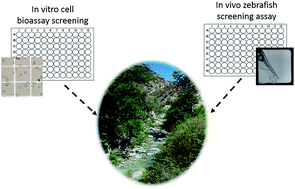High throughput in vitro and in vivo screening of inland waters of Southern California
Abstract
The impact of unmonitored contaminants, also known as contaminants of emerging concern (CECs), on freshwater streams remains largely uncharacterized. Water samples from 31 streams representing urban, agricultural and undeveloped (i.e., open space) land use in Southern California (USA) were analyzed for in vitro and in vivo bioactivity. The extent and magnitude of bioactivity screened using endocrine-responsive cell bioassays and a fish embryo screening assay were low. In contrast, a wider gradient of responses for the aryl hydrocarbon receptor (AhR) assay was observed, which was negatively correlated with a measure of benthic community structure. Both aromatic and non-aromatic CECs were tentatively identified in these samples, but polycyclic aromatic hydrocarbons (PAHs), known AhR agonists in urban environments, were not present at detectable levels. These results suggest that a combination of in vitro and in vivo show potential as screening techniques for biological condition in situ, but that more advanced, comprehensive analytical methods are needed to identify bioactive contaminants.

- This article is part of the themed collection: Bioanalytical tools for water and sediment quality assessment


 Please wait while we load your content...
Please wait while we load your content...